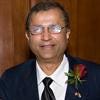Cardiac Control Center [CCC] Functioning
The continuous beating of the heart 24x7x365 in a human body is regulated through Cardiac Control Center (CCC). It is a highly complex control mechanism. So, let me try to make it simple that even a child can understand its functioning. The closest simile to CCC is of a State-of-the-Art Traffic Control Signal System on a busy road crossing of a city. The cameras installed on a busy road crossing, monitor the traffic density of passing vehicles and those waiting on the other crossroad to get their “GREEN” signal. This feedback mechanism is designed and controlled through an optoelectronic and vibration sensor-based software mechanism, which ensures traffic is made to proceed or stop at regular intervals depending upon the traffic density. The signal stops functioning only when there is no electric supply. Let us now scale the same to the functioning of the heart through the CCC figures below.
At a macro level, the control mechanisms which regulate the heart rate can be grouped into Intrinsic and Extrinsic controls. The intrinsic mechanism caters to includes the myogenic sublevel and the sublevels of cell-to-cell communication, the cardiac nervous system, and humoral factors produced within the heart.
On the other hand, the neuronal, humoral, reflex, and chemical regulatory mechanisms constitute the Extrinsic control.
To make it simpler, broadly speaking let us see how the following then function
1. Neural Control
2. Hormonal Control
3. Intrinsic control
Together in an integral manner the above three functions to regulate heart rate, myocardial contractility, and vascular smooth muscle to maintain cardiac output, blood flow distribution, and arterial blood pressure.
Source: slideplayer.com
Neural control operates through nerves. Since our body’s nerves are spread all around, hence our physical activity signals are picked up and then relayed to CCC located in the Medulla Oblongata as shown in Fig 1 above. The autonomic nervous system (ANS) being a part of the peripheral nervous system (PNS), controls cardiac muscle contraction, visceral activities, and glandular functions of the body. So, the receptors in the body pick up increased physical activity or otherwise, and then send signals to CCC in the Medulla Oblongata through Vagus Nerve. The ANS within the brain then directs the SA node located in the Right Atrium of the heart to either increase the heart rate of pumping or slow down
Further, movement of the joints and muscles are picked up by the Proprioceptors (Golgi tendon organs). If there is an increase in physical activity on account of running or exercise or climbing stairs etc., then the proprioceptors pick up this change and relay the information to the CCC, which increases HR and stroke volume (SV) to meet demand.
Almost simultaneously the Baroreceptors register changes in the blood pressure due to say exercise and send signals to CCC. Further, the Chemoreceptors existing in the muscle tissue, aorta, carotid, etc. register changes in the pH value. This happens as physical exercise or increase in activity results in an increase in the consumption of Oxygen and its conversion into Carbon Dioxide. It results in an increase in Carbonic Acid or an increase in acidity thereby lowering the pH value, Also, there is an increase in Lactic Acid production, so combined with the Carbonic Acid, the blood pH lowers. Such changes are picked up by the Chemoreceptors and information is relayed to the CCC, which increases HR and SV.
The myocardial cells which make the walls of the heart have yet another unique property for spontaneous electrical activity which gives the heart the potential to have an internal control just in case SA or AV Node defaults or starts malfunctioning. SA node is also known to the common man as the Natural Pace Maker of the heart. This, one can notice is different from the external two controls mentioned above. Though in the normal heart spontaneous electrical activity is confined to a special region by this uniqueness, in many myocardial cells.
Source: pumpcell.com
Also, in parallel, the Heart Rate is controlled by the two branches of the autonomic (involuntary) nervous system. These are
1. Sympathetic nervous system (SNS) and
2. Parasympathetic nervous system (PNS).
While SNS acts in increasing the heart rate by the release of the hormones catecholamines — epinephrine and norepinephrine if the body demands (such as at the time of exercise) and PNS acts by lowering the heart rate (at the time when the body is relaxing); and both relay their signals to the CCC located in the Medulla Oblongata Portion of the brain. Fig 2 above shows how the SNS and PNS are connected to the Vagus Nerve that ultimately catches the signal to transmit it to the brain having the CCC for regulating the heart rate. And all this has the running thread of electric signals, just like the traffic control stated in the beginning.
Cameron Ahmad
Code: PHDM -10
Aug 26, 2021
Brampton ON
Canada
